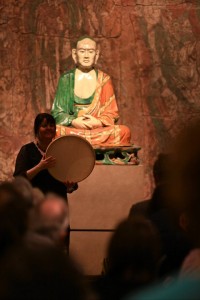Telling the images
What is it that holds an audience’s attention in a storytelling performance? Of course it is the story, and it needs to be a good one! But telling a story imparts more than just plot. Images, feelings, atmospheres, memories, energies are also communicated. So what does the teller need to do, to make the story live, and sustain that attention?
The experience of storytelling is rooted in the process of visualization. Telling the images, rather than remembering words. Powerful visualization involves more than just sight, it is layered and multi-sensual, encompassing emotions, desires and histories. It is a physical experience, involving a body of memories.
The teller needs to balance physical and vocal presence, with the ability to conjure images. The voice can play with volume, tone, diction, stress, silence, phrasing, rhythm. Illustrative gestures evoke the world of the story, and stylized gestures carry the pace of the telling. This physical vocabulary creates a space where the images can appear. Both images of the story, and the emotional, poetic, philosophical …. images behind these images! Along with this, the teller needs to see audience and story at the same time. It’s a delicate process, and sometimes feels like walking a tightrope! Too much, and the teller gets in the way of the story. Too little, and the story doesn’t come to life.
The images of the story are remembered and communicated through the physicality of the performance itself. The emotional truth of the images are embodied by the teller and made real. Telling stories demands immense energy, and the first stage of this is visualization.
Visualization of a story
This exercise needs time and space
Close your eyes, and see the story, as if it is a film, in your mind’s eye. Try and see it in as much detail and as vividly as you can. Use all your senses as you journey through the story scene by scene. Look out for moments of humour – I have got some of my best jokes from this process. Look out for moments of inconsistency – where the logic of the plot doesn’t hang together, take note and work out what you need to change. Look out for emotions and memories that you can weave within your tale.


Leave a Reply